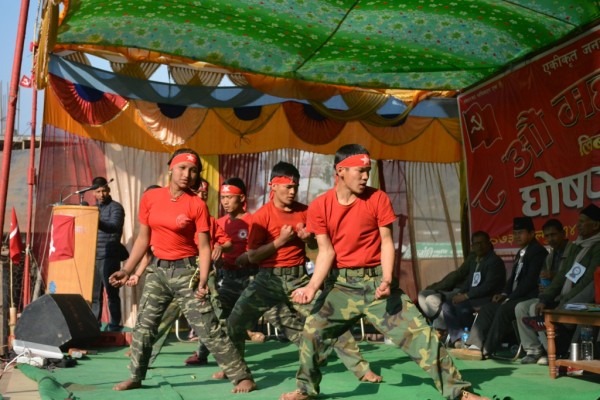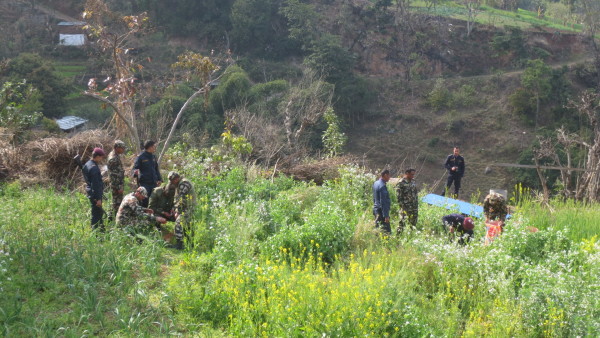MANTRAYA INTERACTION#02: 02 SEPTEMBER 2019
INTERACTION WITH DR. THOMAS A. MARKS

(Biplav group agitprop in Liwang (also, Libang), Rolpa, 25 February 2017. Photo Courtesy: Marks collection)
Background
When did you first visit Nepal?
I first visited Nepal during the Vietnam War, so it was perhaps late 1974 or early 1975. I was studying Buddhism as one of the sub-areas in my doctoral work, and at that time Nepal was a source of knowledge and publications, especially on Tibetan Buddhism. Added to this was a longtime study of the Gurkhas, which ultimately led to my spending periods of time with all (then) five battalions as a journalist. I published a number of academic works on the Tibetan and Himalayan Buddhism, a number of media works on the Gurkhas. Being engrossed in the study of Nepali society, examining political aspects, such as the quest for democracy, came naturally.
What was your impression of Nepal?
What struck me immediately was how very different Nepal was from Southeast Asia, where I had already done a good bit of fieldwork. In my doctoral work, I focused upon the Theravada Buddhist countries, especially Thailand (the others being Cambodia, Laos, and Burma). They had undergone profound change as a result of the Vietnam War, yet they had never been as isolated as Nepal has been until relatively recent times. Hence all socio-economic and political facets of life were very conservative. Things were changing, but even the international linkages engendered by religion, cross-border trade, and the Gurkha phenomenon had not impacted the population at large.
How many times have you returned to Nepal?
Since that first trip, I have been here more times than I can recall. My primary doctoral focus, though, once I transferred from History to the Political Science Department at the University of Hawaii, was political violence. That is the area where you will find most of publications focused – a natural consequence of being in the army during the Vietnam era. My dissertation dealt with Maoist insurgency, which is what led to my dramatically upping the tempo of my visits to Nepal throughout the past nearly two decades.
How do you describe changing dynamics of Nepal, socially, economically, and politically? Can you elaborate on the changes you have just mentioned?
The greatest changes stem from Nepal’s engagement with the outside world. It is now thoroughly intertwined in global forces, regardless of the still existing, widespread nature of traditional forms. This has led to a remarkable synthesis of fluidity and conservatism.
Can you relate any particularly memorable experience?
Several such incidents, since that is the nature of Nepal. Simply being a haole(as we call white people in Hawaii) seeking to get clean in a river is enough to send tremors of mirth and merriment throughout a district (in the case I have in mind, it was Rolpa as I returned from Maoist-held areas). There is a research aspect here, which appears in any number of scholarly works. At times, it is difficult to move beyond Nepal, the warmth and genuinely likable nature of its people, to assessment of the sheer horror any number of us have encountered over the past several decades. As was the case in Cambodia, one is left to puzzle just what drives certain crimes. In my scholarship, you will find the balance between structure and agency invariably examined, but I do not accept that individual misdeeds are a necessary consequence of Nepali societal structure. It thus pains me deeply to see Nepalis inflict harm on each other to the extent they have in recent history.
As context has changed, have your interests and purpose also changed with respect to Nepal?
Ironically, I am more engaged in studying Nepali society than I have ever been, especially the historical Buddhist links that at one point saw the Kathmandu Valley central to the exchange of ideas and ritual which extended, in the north, to Tibet (and even China), in the west, to Kashmir, in the east to Sikkim and beyond, and in the south, back into India. Simultaneously, as my scholarship on Maoist people’s war matured, I went ever deeper into that phenomenon in Nepal. This is, in many ways, an entirely logical consequence of it being one of the more recent conflicts I have studied and done fieldwork on, as well as the simple reality that in this conflict, foreigners were not overtly attacked. In contrast, in the likes of, say, Cambodia, where the Khmer Rouge saw themselves as Maoists on steroids, every foreigner they captured, save one, if memory serves, met a horrible end.
Maoist Research
Why did you become interested in studying Nepali Maoism and Nepalese politics in general?
Beyond what I have already noted, what attracted me to Nepali Maoism was the deep thought that the would-be revolutionaries put into examining both theory and practice, particularly into what had caused groups that seemed on the verge of success, such as Shining Path (Sendero Luminoso) in Peru, to fail. If you examine my larger body of work on Maoism, you will find extensive conversations with the insurgents themselves, and this is what I eventually was able to do here. Their thinking was the essence of politics, whether violent or otherwise: how do we shape the world to address the challenges that society faces? I do not agree with the course of action chosen by the Maoists, but it is necessary to understand their beliefs and programmes.

(Security forces disarming IED found in front of Nepali Congress Party office, Liwang, Rolpa, 7 March 2019.
Photo Courtesy: Marks collection)
You have seen the Maoists in the war period, during the peace process, and in the post-conflict years – and now in the mainstream. How do you analyze their journey? Is it a failure or a transformation?
What is most impressive about Nepali Maoism as a political body is its keen understanding that violence is but a way to get to the objective, which is political power to carry out societal transformation. The fierce debates that have gone on throughout not only the Maoist movement but the larger Nepali communist movement all revolve around this point. The debate has not concluded, as illustrated by the Biplav phenomenon. This much is well known. What is less understood is that there was never a strategic decision to integrate into normal politics. Rather, at the September 2005 Chunwang meeting, there was a decision – some eleven high-placed individuals were present – to embrace the peace process tactically for the strategic purpose of gaining access to the remaining areas of government strength and then seizing power from within. That this was agreed is stated in the formal documents (in Nepali) that emerged from that meeting – and vociferously in the critique of the Dahal mainstream by the radical elements of the party. The result was the bombing campaigns by, first, Baidya aka Kiran, connected with the Second Constitutional Assembly (CAII) elections, later by Chand aka Biplav, pursuant to the effort to block the local and federal elections. Their point, made myriad times, was that a strategy had been agreed upon at Chunwang but had been betrayed by the Dahal aka Prachanda faction (with Dr. Bhattarai invariably also mentioned by the critics). This position, of course, is correct. In this regard, it is important to establish the historical record. I maintain that what has happened in recent Nepali politics is a result largely of contingency, together with a good dose of strategic flexibility upon the part of the Dahal faction. It is not, however, what was intended. Indeed, it is not difficult to find, in both Nepali or English, what was intended – and it was not reintegration into the parliamentary system.
Can you speculate then on why they have come into mainstream politics?
What I have just noted leads to this question. Participation in the peace process was understood by all major Maoist players to be a tactic, not a fundamental strategic shift. The widespread use of violence to ensure electoral results speaks to this. I label this terrorism in my own work, because it fits the definition (instrumental use of symbolic violence by sub-state actors to attack the innocent to further political ends). Military action was placed on hold, but aggressive use of violence continued, with victims numbering in the thousands if not the tens of thousands (even murders, assaults, torture-rape). This is a point conveniently overlooked in recent scholarship, which has been teleological in the extreme, projecting backwards from where we have ended up and misstating the historical record. A large portion of the weapons, for instance, were not surrendered. Nepal, in other words, has been as lucky as it has been committed to a “Nepali solution” in what has resulted.
How do you see two big communist parties’ unification? Is it natural or a more contrived process? Some analysts have speculated that there is a China factor behind this unification.
Unification followed, on the one hand, from the weak structural position of the Maoists. They needed unification, or they simply were not going to any longer be a major factor in the restructuring of Nepali society. On the other hand, the Maoists and the UML indeed are both communists and believe in Marxist-Leninist dogma. This is a factor which has long been overlooked simply because the precise nature of Nepali communism is specific to its national setting. There is a regular tendency to claim they are “not real communists.” This is not correct. They are simply constrained in what they can go by Nepal’s societal and geostrategic realities. They do actually believe the more egregious things they say, whether backing Cuba, Venezuela, China, and North Korea, or claiming that rape stems from capitalism (and presumably vanishes under communism).
If this unification continues, what do you see is the future of NCP?
There will continue to be extreme factionalism, because the beliefs of the Maoist faction are not entirely compatible with those of the UML faction. One readily sees this in Dahal’s insistence upon embracing publicly some of the most egregious regimes in the world, those I have just mentioned. This itself, ideology aside, should puzzle Nepalis. That list is not exactly one of democratic, representative societies. This leads to a conundrum: how is it that ostensible Nepali democracy keeps turning to odious regimes for ideological sustenance?
The Communist Party has considerable support in Nepal. Why has the communist government been unable to deliver on its promises despite having a two-thirds majority?
Nepal is dominated by the market on the vocabulary of social justice having been adroitly conflated with that of Marxism by Nepali communists. What emerges from numerous interviews with Nepali communists is more akin to what one finds in European social democracy than hard-core Marxism. Voters, thus, opt for the organization which best conveys a message of equality and justice even as they are mobilized by solid organizational mechanisms. Therein lies precisely the danger. Leaders are not followers; politicians are not voters. And too many of the communist leaders are currently in thrall to the nonsense that “authentic” national communism really can deliver on the promises of Marx and Lenin. As neither of those figures had much realistic to offer, the results can only be muddled if not tragic.
Biplav Factor
How do you see Biplav position in Nepalese politics?
Biplav, ironically, has a fairly astute assessment of the present ills of Nepali society, whether incompetence or corruption or desire to sell out the country to the highest bidder (presently China). Where he comes up short is in failing to offer a viable way forward. Ironically, this is precisely the critique the Biplav group advanced for splitting with the Baidya faction. Beyond such generalities, though, there is the fundamental matter that violence is not the way to gain progress.
What is their future?
The Biplav group is presently using violence as messaging. Its actions have produced some casualties, but these were perhaps not intended by the leadership. Unfortunately, the party lacks discipline, and what occurs at the local level is another matter altogether, a very violent matter. Violence, in fact, remains widespread and is an integral part of the Biplav group’s fundraising and the establishment of local political domination in the areas where it is seeking to reconstruct the apparatus of the previous people’s war. It is this violence which has ceded the battle of dueling narratives to the government. Whatever the government’s flaws, to include its own widespread use of violence in local space (I am thinking of the YCL and ANNISU-R, in particular, but there are many other candidates), it holds the high ground in at least outwardly appearing to address the deep-felt desire of the Nepali people for democracy, consultation, and advancement. Where the government comes up short is well known. If it does not correct its authoritarian tendencies, it will fail. In the Economist Intelligence Unit (EIU) rankings, Nepal is not even classified now as a full democracy, rather in the third tier of four, as a “hybrid regime”, 97 of 167 in the global ranking. It is to this reality that Biplav claims to speak. Unfortunately, his group has not come up with a realistic way forward.
(Dr. Thomas A. Marks has conducted extensive field work and has written prolifically on insurgency and Maoism in Nepal. Interviewed in July (2019) for Mantraya by Nepali journalist Rajaram Gautam, he offered his views on the current security situation. This interaction is a part of Mantraya’s ‘Mapping Terror and Insurgent Networks’ project. Opinion expressed here is that of Dr. Marks)


